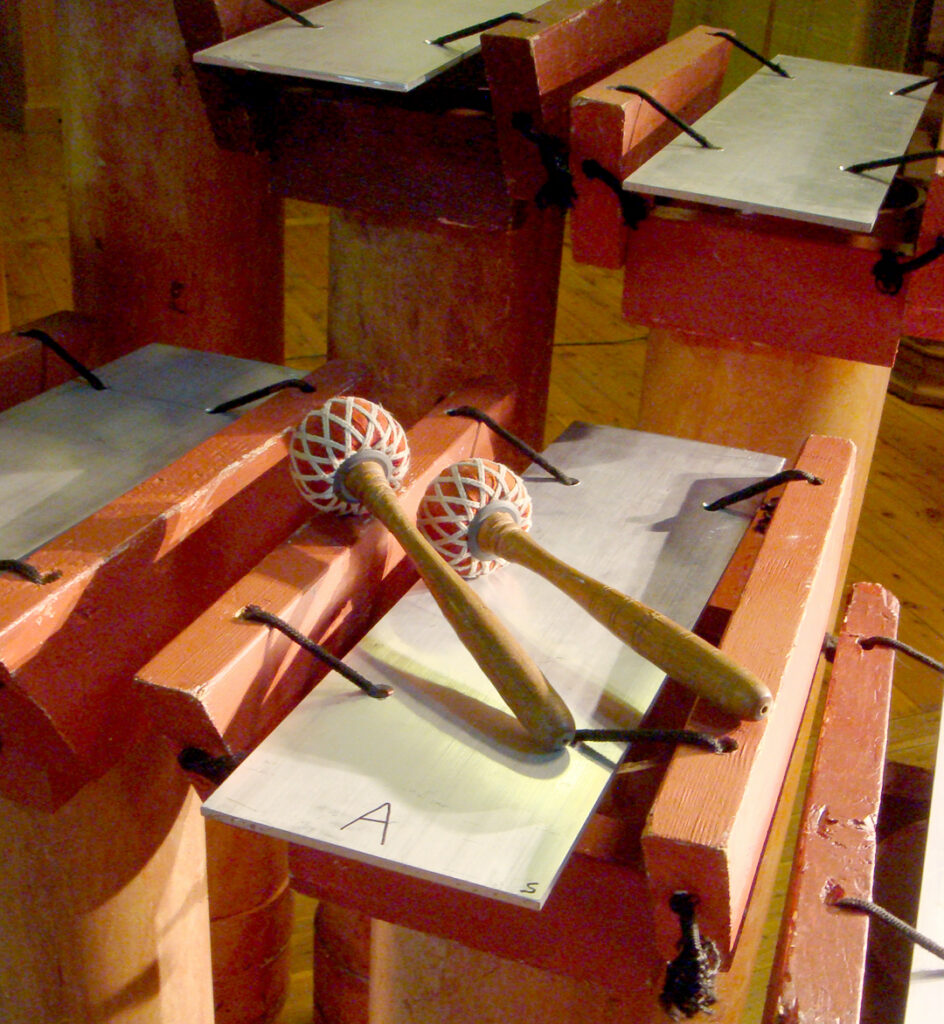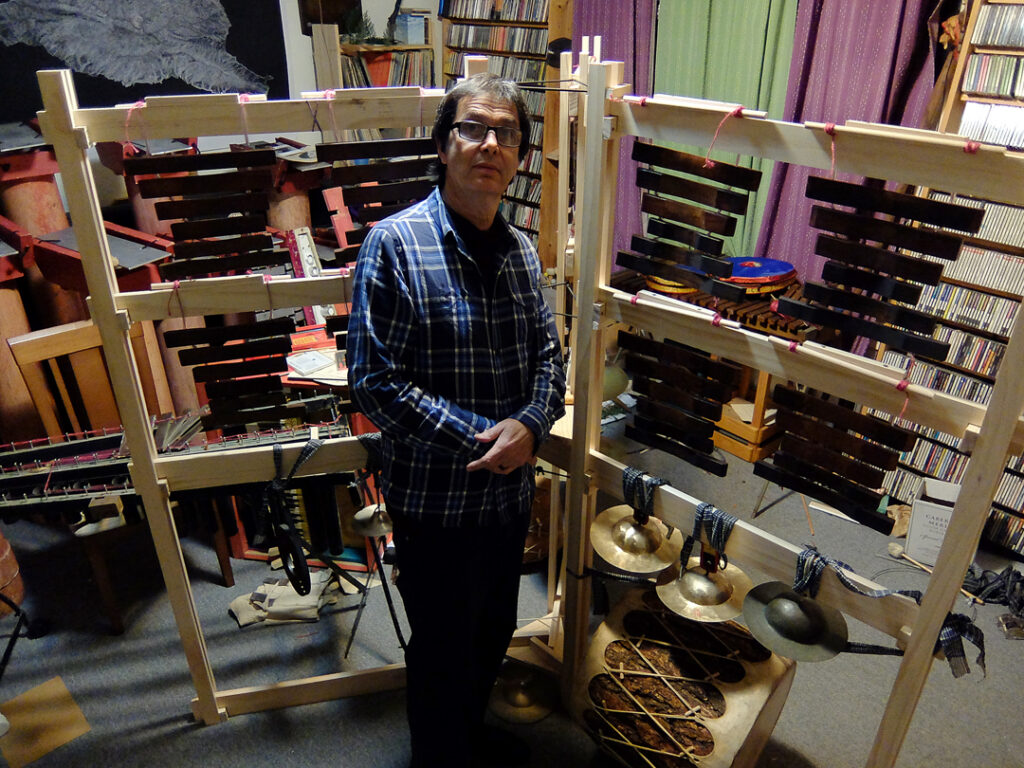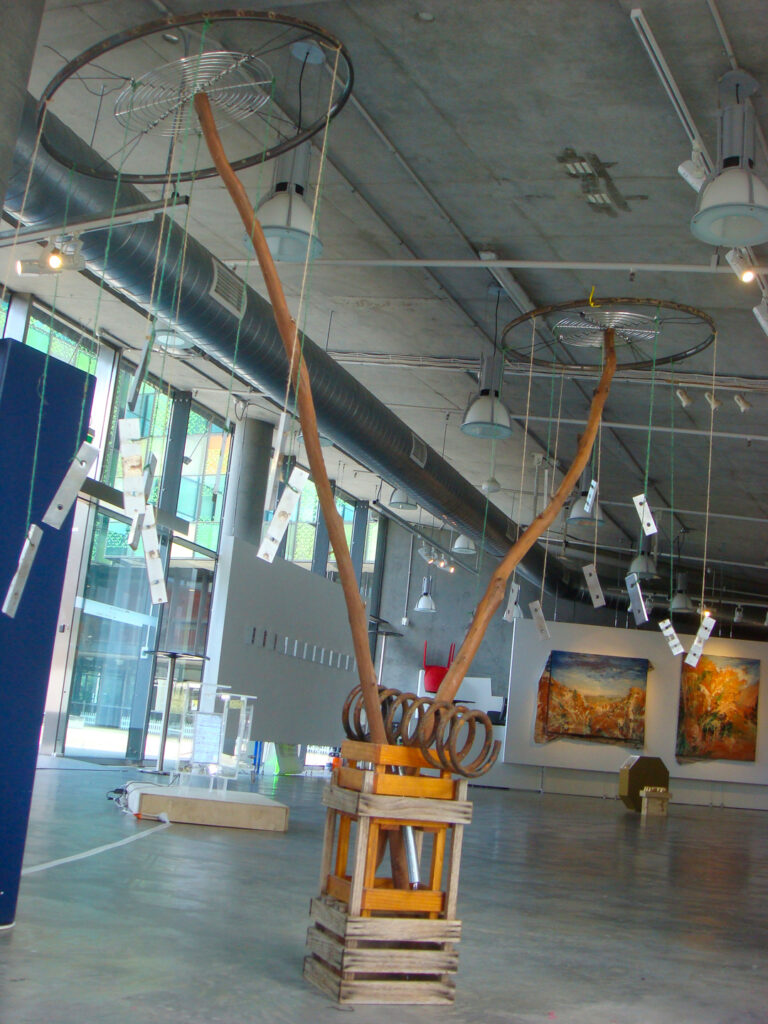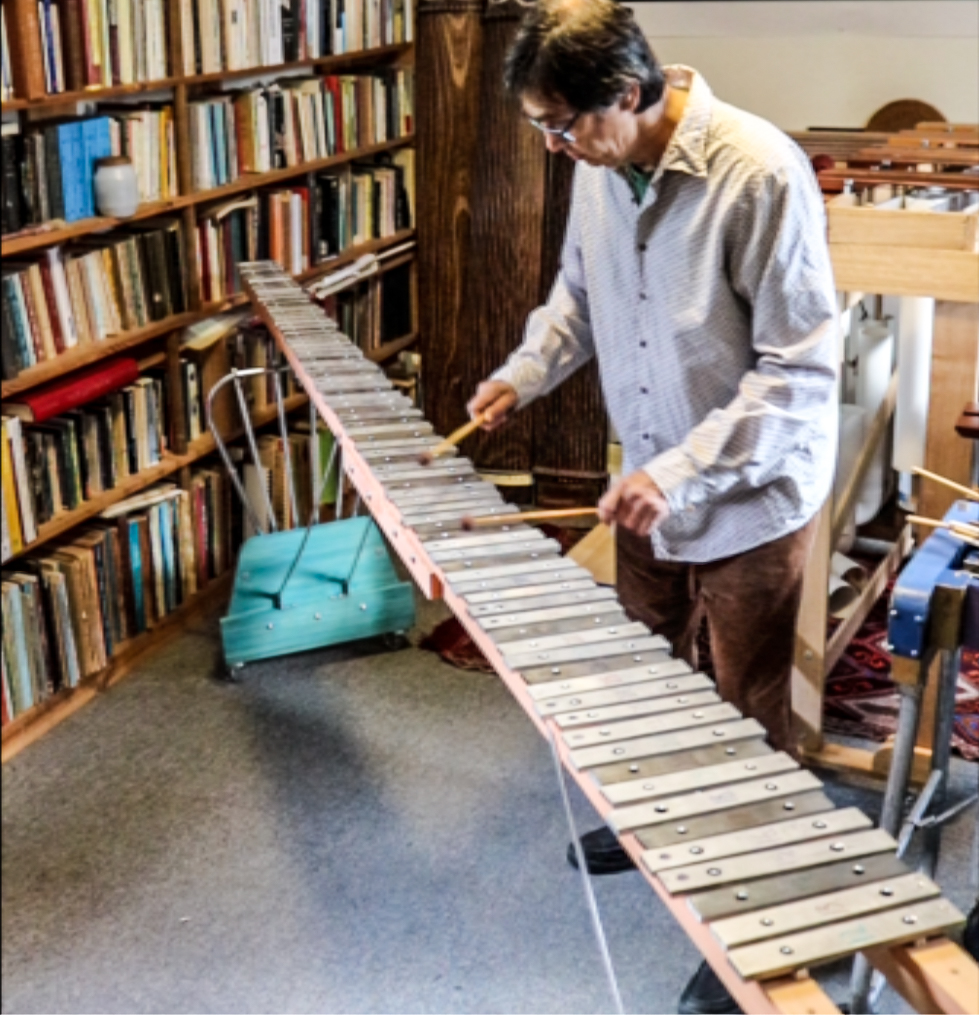Kraig Grady identifies the instruments unique to Anaphoria Island.
(A message to the reader.)
Part of the oceanic mesocosm, Anaphoria Island is 1,600 km from the nearest major land mass. No place on earth rivals its cultural diversity. So long a home and host to migrants from all over the globe, known even to its inhabitants as the “Isle of Exiles”, Anaphoria’s myths and history feature many outcasts who appear from distant lands and inadvertently help overcome local crises.
The musical instruments of Anaphoria Island explore the borders between inner and outer geographies. With the latter, there are the “facts” that show how the instruments came about, while the former is best expressed in the language of myth and fiction as the most accurate vehicle of communicating why. These instruments form a “poor orchestra” used in strictly musical performances and as sonic characters in the Shadow Theatre of Anaphoria. Each instrument interacts with the others just as an individual interacts with a community. When new ones are developed, they are conceived in terms of how they might expand this community, not only harmonically but also to fill in colours and ranges, as opposed to being an independent unit. But each instrument can serve as a solo instrument when necessary. The feature shared among all the instruments is their common tuning scale.
A scale or pitch palette used by a community of people becomes part of their identity. The instruments reflect the environment through the materials and resources from which they are made. Anaphoria is thus a place that can be defined and recognised solely by the sound of its instruments. Like most places, its music is not homogenous in style or texture but reflects the different ways its inhabitants use music in their lives.
The first of these instruments from Anaphoria Island was the Reed Organ. The story told is that this instrument was left over from The Great Missionary Expulsion of 1823. Around this time, it was shunned due to its origin and almost destroyed, but at the last minute was saved by an instrument builder from Lipari who realised that the Reed Organ could be retuned to a scale widely used on the Island. He thus saw it as providing new musical opportunities for the traditional music of Anaphoria, mainly from its ability to hold notes for unlimited periods of time. He retuned the instrument and presented it to others.
At first, this tuning comprised a pair of pentatonic scales slightly mistuned from each other. This tuning used 10 out of the 12 notes available per octave on the keyboard. Later, informed by a 4,000-year-old diagram known in India as Meru Prastara, he could see how the two unused tones could be unified in a complete and unique 12-tone cycle. This act became the prototype of how other Western instruments could be retuned to suit the music of Anaphoria. Soon a whole array of retuned instruments emerged, deceptively looking like their Western counterparts but bearing no resemblance in sound.
The Reed Organ is a relatively simple instrument despite the mystery of its workings. It is played by pumping a pair of foot pedals which expands the bellows, creating a vacuum in the cavity so that when any key is pressed, air is sucked through elongated holes obstructed by tuned brass reeds. Such an instrument has a great appeal, enabling a single player to sustain full harmonies and multiple lines. A set tuning also provides a reference and support for other instruments with more flexible pitch. The portability of the Reed Organ is also important, and it does not require electricity, making it an ideal instrument for performances in the open environment.
This act of “decolonisation” of the instrument was not without difficulties. The final tuning required two different sets of brass reeds from two different organs. Each reed has a set size designed to play a particular Western pitch and can only be retuned within a somewhat limited range. The reed is attached at one end and vibrates in much the same way a ruler vibrates when struck while held at the edge of a table. The pitch is modified by filing the reed at the end to raise the pitch or filing it at its base to lower it. The organ’s design originally had a second set of reeds that can be opened with a knee pedal, allowing for an increase in volume. This second set of reeds normally sounds an octave higher, but since the instrument is used mainly in the company of other percussion instruments, this set was tuned to a unison to enhance the volume.
As often happens, the Reed Organ scale was independently discovered by microtonal theorist Erv Wilson as part of a whole family of scales derived from the different diagonals of Meru Prastara, an enigmatic triangular array of numbers. He called the family of scales derived from a particular diagonal Meta-slendro, meaning “slendro-like” because of its similarity with the slendro scale found in distant Indonesia.
There has been a logical and pragmatic progression in which the poor orchestra of Anaphoria Island grew. Using neglected or obsolete instruments or making instruments from readily accessible materials has allowed it to grow under limited economic conditions. It resembles the process of the former hobo Harry Partch who also created an ensemble of unique instruments. While Partch’s ensemble grew without an overall plan, thus resulting in instruments that did not always match in terms of volume and timbre, the instruments of Anaphoria were conceived as a unified ensemble from the beginning. In addition to the Reed Organ, other sustaining instruments, such as retuned Vibraphones, form the backbone of the orchestra. A set of gong-like metal Meru Bars provide the lowest tones. The Poles are a set of vertical tubes suspended from the middle instead of near the end. They are played by striking the tubes, which can be placed in any order to allow a mix of chords and melodic patterns to be set up for specific compositions.
- The Meru Bars
- The Poles
Wooden instruments such as a retuned Marimba and a Bass Marimba have faster decay sounds that allow for swifter playing motions. Also, the Bass Marimba provides a clearer-sounding tone than its metal counterpart. The Gate is an instrument of hanging wooden bars made from the relics of multiple damaged instruments. It is played by scraping downward over the set of bars tuned to various chords.
- The Gate
- The Tree
The Tree is unique in its role as mainly a solo instrument. Its metal bars hang from string and rotate after being struck, causing a phasing effect. This spinning action tends to impose unusual rhythms as the movement makes it impossible to play quickly. Its floating, atmospheric character brings spaciousness to the overall sound of the orchestra.
The newest instrument is the Escalade, made from four marching band glockenspiels arranged in a continuous row spanning over three metres. This instrument extends the tonal range upward while filling in the scale’s gaps with 37 pitches in the octave. The primary purpose of this instrument is to provide the feeling of unusual sliding between tones.
Through the sounds emanating from these instruments, the inner and outer geographies of Anaphoria Island are made incarnate.
Further Reading List
Warner, G “The Shadow Theatre of Anaphoria Island”
The Austronesian Embassy of Anaphoria Island
Harlan, Brian T. “Notes from the Inner Ground: An Interview with Kraig Grady”
About Kraig Grady
 Kraig Grady (born 1952) is a US-Australian composer, instrument builder and sound artist. His compositions include accompaniments for silent films and shadow plays performed with a bespoke ensemble of microtonal instruments of his design, including metallophones, marimbas, hammered dulcimers and reed organs, all tuned to microtonal Just Intonation scales. Many of Grady’s compositions use unusual meters of very extended lengths. He has worked as a shadow puppeteer, tuning theorist, filmmaker, world music radio DJ and concert promoter. A significant influence in the development of Grady’s music was composer and music theorist Harry Partch, like Grady, a musician from the American Southwest and a composer of theatrical works in Just Intonation for self-built instruments.
Kraig Grady (born 1952) is a US-Australian composer, instrument builder and sound artist. His compositions include accompaniments for silent films and shadow plays performed with a bespoke ensemble of microtonal instruments of his design, including metallophones, marimbas, hammered dulcimers and reed organs, all tuned to microtonal Just Intonation scales. Many of Grady’s compositions use unusual meters of very extended lengths. He has worked as a shadow puppeteer, tuning theorist, filmmaker, world music radio DJ and concert promoter. A significant influence in the development of Grady’s music was composer and music theorist Harry Partch, like Grady, a musician from the American Southwest and a composer of theatrical works in Just Intonation for self-built instruments.









